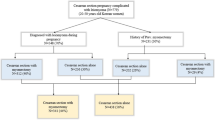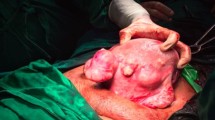Abstract
Aim
To evaluate the outcome of a cesarean myomectomy (CM) versus a cesarean delivery (CD) alone in women with uterine myomas and the risk factors for adverse outcomes.
Methods
A retrospective cohort study of all women undergoing CDs with uterine leiomyomatas and singleton pregnancies was performed. Patients with known risk factors for hemorrhage were excluded. Measured adverse outcome parameters included estimated blood loss, drop in hemoglobin levels (pre/postoperatively), operation time, and the use of additional uterotonics. Outcome parameters of women with CM were compared to women with CD alone. Possible risk factors for adverse outcomes were analyzed in a multivariate regression analysis. Evaluated risk factors for CM were according to localization and type of myomatas, the myoma size, BMI ≥30 kg/m2, age ≥40 years, fetal weight ≥4 kg, repeat CD, and unplanned CD in the first stage of labor. The influence of localization and myoma type were further analyzed in a subgroup analysis.
Results
Of the 162 women with uterine myomatas during CD, 48 underwent CM and were analyzed. Overall, CM was not associated with adverse outcomes. Independent of a concomitant myomectomy, a large myoma size of ≥5 cm was associated with an increased blood loss of ≥500 ml (adj. OR 2.7 CI 95 % 1.2–6.2, p = 0.02), and women ≥40 years of age had a significant postoperative drop in hemoglobin (adj. OR 2.4 CI 95 % 1.0–5.4, p = 0.04). In the univariate subgroup analysis, CM of multiple myomatas was associated with an increased blood loss and an increased operation time compared to women with multiple myomatas and CD alone. Prolonged operation times were also observed in women with pedunculated and subserosal myomatas with concomitant myomectomy. There were no cases of hysterectomy or blood transfusions.
Conclusion
CM performed by an experienced obstetrician can be safe in selected patients who are without additional preexisting risk factors. Risk factors that are associated with increased blood loss in women with uterine leiomyomatas include a larger size of the leiomyoma (≥5 cm) and a maternal age of ≥40 years.
Similar content being viewed by others
References
Al-Zirqi I, Vangen S, Forsen L et al (2008) Prevalence and risk factors of severe obstetric haemorrhage. BJOG 115:1265–1272
Blomberg M (2011) Maternal obesity and risk of postpartum hemorrhage. Obstet Gynecol 118:561–568
Cook H, Ezzati M, Segars JH et al (2010) The impact of uterine leiomyomas on reproductive outcomes. Min Ginecol 62:225–236
Declercq E, Young R, Cabral H et al (2011) Is a rising cesarean delivery rate inevitable? Trends in industrialized countries, 1987–2007. Birth 38:99–104
Heffner LJ (2004) Advanced maternal age—how old is too old? N Engl J Med 351:1927–1929
Hill M, Reed KL, Cohen WR (2014) Oxytocin utilization for labor induction in obese and lean women. J Perinat Med 43(6):703–706
Klatsky PC, Tran ND, Caughey AB et al (2008) Fibroids and reproductive outcomes: a systematic literature review from conception to delivery. Am J Obstet Gynecol 198:357–366
Kwawukume EY (2002) Myomectomy during cesarean section. Int J Gynaecol Obstet 76:183–184
Lam SJ, Best S, Kumar S (2014) The impact of fibroid characteristics on pregnancy outcome. Am J Obstet Gynecol 211(395):e391–e395
Lao TT, Sahota DS, Cheng YK et al (2014) Advanced maternal age and postpartum hemorrhage—risk factor or red herring? J Matern Fetal Neonatal Med 27:243–246
Pergialiotis V, Vlachos DG, Rodolakis A et al (2014) First versus second stage C/S maternal and neonatal morbidity: a systematic review and meta-analysis. Eur J Obstet Gynecol Reprod Biol 175:15–24
Song D, Zhang W, Chames MC et al (2013) Myomectomy during cesarean delivery. Int J Gynaecol Obstet 121:208–213
Szamatowicz J, Laudanski T, Bulkszas B et al (1997) Fibromyomas and uterine contractions. Acta Obstet Gynecol Scand 76:973–976
Tinelli A, Malvasi A, Mynbaev OA et al (2014) The surgical outcome of intracapsular cesarean myomectomy. A match control study. J Matern Fetal Neonatal Med 27:66–71
Vitale SG, Padula F, Gulino FA (2015) Management of uterine fibroids in pregnancy: recent trends. Curr Opin Obstet Gynecol 27:432–437
Vitale SG, Tropea A, Rossetti D et al (2013) Management of uterine leiomyomas in pregnancy: review of literature. Updates Surg 65:179–182
Author information
Authors and Affiliations
Corresponding author
Ethics declarations
Conflict of interest
The authors declare that they have no conflict of interest.
Ethical approval
The study has ethical approval according to the Institutional Review Board decision for the use of anonymized patient data for medical research (April 13th 2000 and March 1st 2012).
Rights and permissions
About this article
Cite this article
Dedes, I., Schäffer, L., Zimmermann, R. et al. Outcome and risk factors of cesarean delivery with and without cesarean myomectomy in women with uterine myomatas. Arch Gynecol Obstet 295, 27–32 (2017). https://doi.org/10.1007/s00404-016-4177-8
Received:
Accepted:
Published:
Issue Date:
DOI: https://doi.org/10.1007/s00404-016-4177-8




